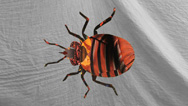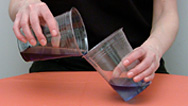The Tongue-Eating Parasite
- By Anna Rothschild
- Posted 03.01.13
- NOVA
Meet the tongue-eating isopod, Cymothoa exigua. This marine parasite feasts on a fish's tongue and then becomes its tongue. You'll never eat seafood again.
Transcript
The Tongue-Eating Parasite
Posted: March 1, 2013
Narrator: I'm about to introduce you to one of the grossest creatures on earth—it's the tongue-eating isopod, Cymothoa exigua.
Isopods are crustaceans, like lobsters and crabs. This particular isopod happens to live in the ocean and is a parasite. It's a sort of…marine louse. Only it's way creepier.
Anyway, the first crazy thing to know about these guys is that they're what's called "protandric hermaphrodites." That means that when they're adults, the males can become females. These isopods infest fish, so what happens is that a number of juveniles enter through the fish's gills, and all mature into males. Then, one of the isopods will become a female and that's when everything gets really freaky.
The female will crawl into the fish's mouth, and attach herself to the base of the fish's tongue using her back legs. Then, she'll suck blood from the tongue until it withers and dies. This procedure is quite unpleasant for the fish, but it doesn't kill it. In fact, it starts using the parasite like a prosthetic tongue! Meanwhile the isopod just continues to hang out in the fish's mouth, sucking its blood, or feeding on fish mucus.
We don't know a ton about the parasite's life cycle, but based on other mouth-infesting isopods (and yes, there are others) the female may even mate while in the fish's mouth with male isopods living in the fish's gill chamber!
I know this doesn't sound real, so here is a photograph of a mouth-infesting isopod to prove it.
Thankfully, these guys don't infest humans. But, they do infest fish that we eat. Cymothoa exigua has a preference for snapper, and other mouth infesting isopods prey upon mahi mahi or barramundi. So, next time you're at the grocery store, take a look inside that red snapper's mouth. You might find a tasty treat inside.
Credits
PRODUCTION CREDITS
- Produced, edited, and animated by
- Anna Rothschild
- Production Assistant
- Allison Eck
- Special Thanks
- Stefanie Kaiser
- Original Footage
- © WGBH Educational Foundation 2013
MEDIA CREDITS
- (Ceratothoa sp in Blacktail)
- Host:Diplodus sargus sargus (common names: blacktail or white seabream)
- Locality: Tsitsikamma National Park, Eastern Cape, South Africa
- © Nico Smit
IMAGE
- (main image: Ceratothoa sp in Blacktail)
- © Nico Smit
Related Links
-

Bed Bug Sex
Gross Science: How bed bugs reproduce is the stuff of nightmares.
-

Five Reasons to Eat Insects
Save room for bugs! They're the future of green cuisine.
-

Extract Your Own DNA
Behold your very own DNA in this do-it-yourself science experiment.
-

Fish Surgery
Pet owners are turning to veterinary medicine for costly treatments of their goldfish, koi, and other fish.

